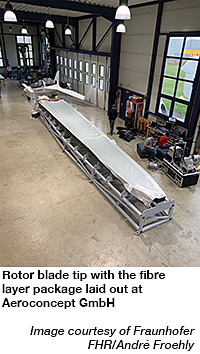Novel radar technique automatically monitors rotor blade manufacturing process
14/06/2023
Identifying defects in fibre composite materials during the production process will be possible in the future due to a novel radar method that automatically and non-destructively monitors the manufacturing process of fibre composite materials such as wind turbine rotor blades. Until now, monitoring has consisted of visual inspections. The Fraunhofer Institute for High Frequency Physics and Radar Techniques FHR in Wachtberg, Germany, has collaborated with consortium partners Ruhr University Bochum, FH Aachen University of Applied Sciences and Aeroconcept GmbH to develop an innovative method in the FiberRadar project.
During the manufacturing process of glass fibre-reinforced structural components, such as those found in rotor blades, the fibre structure is fixed with a resin matrix. Irregularities in the alignment and/or the flow of fibre reinforcement can alter the structural properties and as a result reduce the quality of the final composite material.
“When producing rotor blades, layers of glass fibres are layered on top of each other in a shell. If this is not done accurately, it can lead to various defects such as undulation. But the fibre can also become twisted and therefore impact the mechanical properties of the component,” explained Dr André Froehly, Project Manager at Fraunhofer FHR. It has so far not been possible to reliably analyse the direction and layering of the fibres before the resin matrix is applied, meaning that defects were only discovered afterwards, for instance via ultrasound examination. This made it impossible to control the process chain and resulted in costly rework or sometimes even the scrapping of components.
Researchers involved in the FiberRadar project have now developed a new method that, for the first time, allows the alignment of the lower glass fibre layers to be checked in a non-destructive and automated manner. The process uses a millimetre-wave scanning system consisting of a radar, a fully polarimetric robot and associated imaging software. The system also harnesses the polarisation of the electromagnetic waves, so it can also identify possible defects through a variation in the direction of polarisation. Polarisation is a term used in antenna technology to denote the direction of the electric field component of an electromagnetic wave. The robot scans the component and at each position the radar performs a measurement. These are then combined into a 3D image by the software. While conventional radars only have one channel and therefore use one polarisation for both transmitting and receiving, the new radar sends and receives signals in two polarisations. This not only provides high-resolution fibre structure imaging, but also makes it easy to expose any defects in the deeper layers. Additionally, refraction compensation improves the quality of the images: it reduces unwanted effects due to refraction, especially in deeper layers. Using radar to scan the individual layers, researchers can also identify any anomalies in fibre orientation and examine the entire material volume in a non-destructive manner.
The FiberRadar project combined Ruhr University’s integrated radar technology, Fraunhofer FHR’s algorithm expertise and FH Aachen’s expertise in robotics to create a measurement system that enables the production of fibre composite materials and the control of the manufactured components with levels of precision that were previously not possible. Due to Aeroconcept GmbH’s experience, the technology can be integrated directly into the manufacturing and monitoring process for wind turbine blade production and become a key technology for high-quality composites.
“We are very pleased with the promising results marking the end of the FiberRadar project,” said André. “We plan to use follow-up projects to further develop the system so that it is ready for use in production processes. We are aiming to improve both the speed and the depth resolution to detect even more potential defects in a shorter period of time,” he explained.
The project was funded by the European Regional Development Fund (ERDF).